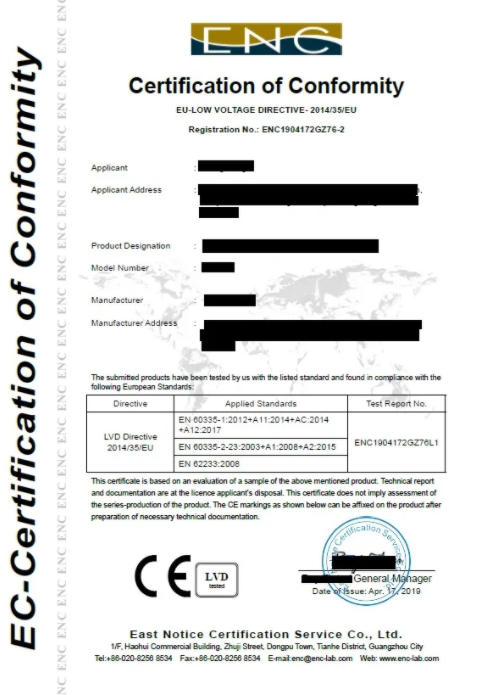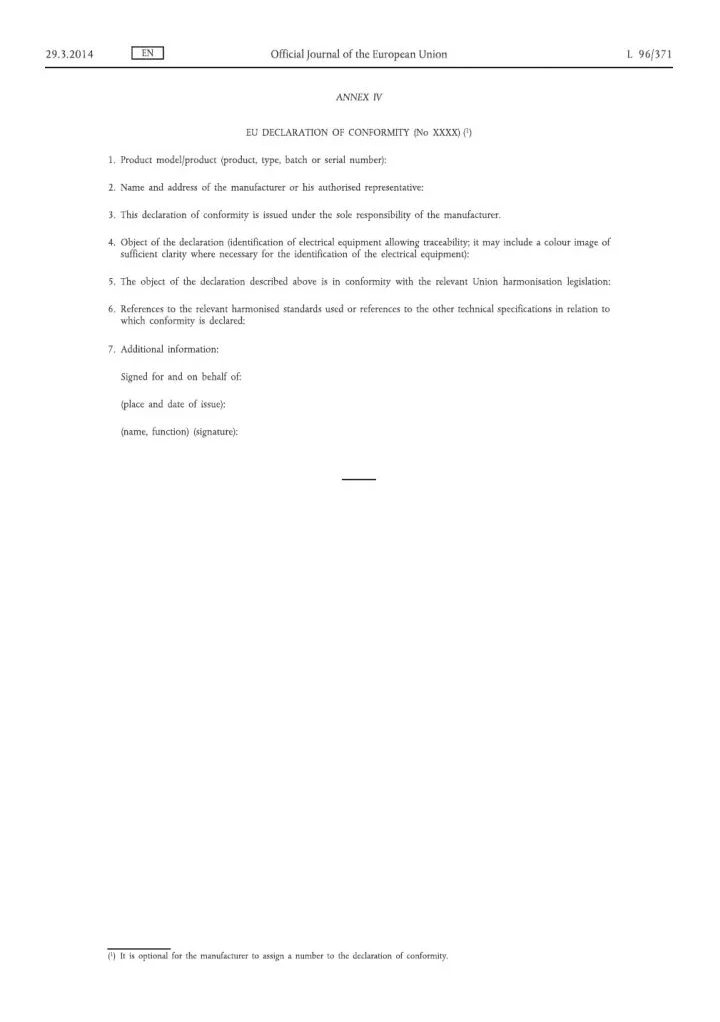The CE Marking, also known as “Conformité Européenne” marking, certifies that a given product conforms to EU requirements and can be marketed in the European Economic Area, which comprises of all member states of the European Union, as well as Norway, Liechtenstein, and Iceland. Below you will find detailed information on the use of this mark in imports and the difference between Declaration of Conformity and the CE Certificate.
What kind of products should the CE Mark be placed on?
Some of the products imported from outside of the European Union must carry a CE Mark, however, it does not concern all of them. EU Directives specify particular product categories that must bear the CE Mark. These are:
- Medical devices
- Active implantable medical devices
- Products used for in vitro diagnosis
- Electrical and electronic equipment subject to RoHS – Restriction of Hazardous Substances
- Cableway equipment designed for passenger transport
- Eco-designed energy-related products
- Products subject to the Electromagnetic Compatibility Directive
- Equipment and protective systems intended for use in potentially explosive atmospheres (ATEX Zones)
- Explosives for civil uses
- Appliances burning gaseous fuels
- Elevators / lifts
- Water heating boilers
- Machines
- Measuring instruments
- Equipment that emits noise in the environment
- Low-voltage (LVD) products
- EMC electronic products
- PED pressure equipment
- Personal protective equipment (PPE)
- CPR construction products
- Pyrotechnics
- Radio telecommunications equipment
- Recreational craft
- Toys for children under 14
- Simple pressure vessels
- Electrical products
Each category refers to a relevant New Approach Directive. These are:
- 90/385/EEC Active Implantable Medical Devices Directive
- 92/42/EEC Boiler Efficiency Directive
- 93/42/EEC Medical Device Directive
- 98/79/EC In Vitro Diagnostic Medical Devices Directive
- 305/2011 Construction Products Regulation (CPR)
- 2000/14/EC Outdoor Noise Directive (OND)
- 2006/42/EC Machinery Directive (MD)
- 2009/48/EC Toy Directive (TD)
- 2009/125/EC Ecodesign Directive
- 2011/65/EU RoHS Directive II and 2015/863 RoHS Directive III
- 2013/29/EU Pyrotechnic Articles Directive
- 2013/53/EU Recreational Craft Directive
- 2014/28/EU Explosives for Civil Uses Directive
- 2014/29/EU Simple Pressure Vessels (SPV) Directive
- 2014/30/EU Electromagnetic Compatibility (EMC) Directive
- 2014/31/EU Non-Automatic Weighing Instruments (NAWI) Directive
- 2014/32/EU Measuring Instruments Directive (MID)
- 2014/33/EU Lifts Directive (elevators)
- 2014/34/EU ATEX Directive (Equipment for potentially explosive atmospheres)
- 2014/35/EU Low Voltage Directive (LVD)
- 2014/53/EU Radio Equipment Directive (RED)
- 2014/68/EU Pressure Equipment Directive (PED)
- 2016/424 Regulation on cableway installations
- 2016/425 Personal Protective Equipment (PPE) Regulation
- 2016/426 Gas Appliances Regulation (GAR)
The directives are updated from time to time, so make sure you are not using an outdated label. When a given directive is updated, all documents should be corrected accordingly.
When placing the mark on a product, the manufacturer is obliged to check its compliance with specific EU safety, health, and environmental requirements. Depending on the type of goods, it might be mandatory to test and assess the conformity of products with the help of certified external organizations.
New Approach Directives and Harmonized Standards
The so-called New Approach Directives are essential provisions that group products together and specify general requirements they must meet. Detailed provisions concerning those products are included in Harmonized Standards. Their designations consist of letters and numbers. One example is the standard EN 62233:2018, visible on the CE certificate (Certification of Conformity) shown below. It is easy to notice that the certificate refers to one Directive and three Harmonized Standards.
Scheme for obtaining the CE marking
It is the manufacturer who is responsible for obtaining the marking and ensuring that all the requirements are met. If a product is subject to more than one Directive, it must conform to all of them. The subsequent steps are listed below:
- Checking the relevant Directives and Standards.
- Verification of the requirements for each product category.
- Finding a certification body located in one of the EU member states, if there is such a requirement for the product group.
- Checking the product for safety, healthiness, and environmental friendliness.
- Preparing technical documentation.
- Assigning the CE marker by the manufacturer or by a designated organization.
As regards imports, it is the importer and not the manufacturer who is responsible for completing the whole process properly. If the Declaration of Conformity is not authentic, complete, or the products are not marked, the importer is responsible. This also applies if the goods are CE marked without a distinct reason – in such a situation the importer will be charged with a fine and all the costs related to the reworking of the whole process. That is why from the very beginning it is important to verify contractors carefully and to maintain control over the whole undertaking.
Declaration of Conformity and the CE Certificate
The CE Certificate is a document issued by a certification body, based on test reports. Each model of an ordered product should be subjected to adequate tests and have its own certificate.

The CE Certificate (Certificate of Compliance/Conformity) includes:
- name of the applicant and their address – if you contact the manufacturer directly, it should be the name of the manufacturer
- name of the manufacturer and their address
- name of the product and its tested model (one certificate can be issued for the main model and its related models, so you must verify if your product’s model is one of them)
- the standards considered during testing – they should be in accordance with the standards specified in the relevant Directive, obligatory for our product
- certificate number.
Declaration of Conformity is, in turn, issued by the manufacturer, based on certificates and test reports. It is necessary for customs clearance.
It should be also noted that “Declaration of Conformity” is an incomplete name of the document. Depending on the Directive applying, we distinguish:
- EC Declaration of Conformity,
- EU Declaration of Conformity,
- Declaration of Performance,
- national Declaration of Conformity,
- national Declaration of Performance.
Declaration of Conformity may look as follows:

Declaration of Conformity includes:
- product name and model
- name of the manufacturer and their address (or name and address of an authorized representative)
- manufacturer’s liability statement
- list of standards and regulations with which the product complies
- date and place of issue of the Declaration
- full name, position, and signature.
CE Marking (affixing the CE Mark)
The CE Mark should be placed permanently and visibly on each product. The marking’s height should be min. 5 mm (unless otherwise specified in the relevant Directive). If it is impossible to affix the CE Mark directly on the product or it is not certain that it will be visible and legible for the consumer, then it is acceptable to put the CE Mark on the label or packaging.
If the conformity of goods with certain Directives has been checked by notified bodies, the identification numbers of all those bodies must be placed next to the mark.
The mark can only be affixed by the manufacturer or their authorized representative on the basis of documentation confirming the compliance of the goods with the relevant standards.
How to recognize a false CE Marking?
Dishonest Chinese manufacturers have become experts in counterfeiting the CE Marking. You may encounter many markings that resemble CE, but have nothing to do with it. The best-known example of counterfeit marks is „China Export” – a mark that at first sight resembles CE, but has no space between the letters. The original mark is two rounded CE letters with a clear gap between them.
Below you will find the relevant CE Marking:

What can you do if the CE Certificate or test reports raise your concerns?
When you ask a Chinese company to send you their certificates, you should also inquire about test reports. If the company refuses, delays submitting them, or stops responding, you can confidently assume that you are dealing with fraudsters.
However, if you have been provided both with certificates and test reports, but they do not seem trustworthy, you should contact the certification body that issued them. In order to report your doubts, you must specify the certificate number.
CE Marking – what should you do if your order arrives without it?
If the products do not bear CE Marking and/or the importer does not hold the proper documents and certificates, the goods will be seized at the border. The documents might be sent by the customs office to the regional trade inspectorate, which decides what will happen next with the goods.
If the supplier holds all the required declarations and certificates, the importer can request his consent to place the CE Mark on products in the importing country. Repair procedures are then applied: the Inward processing procedure or the Customs warehouse procedure. In both cases, there are procedures (including product marking) that aim to allow the goods to be sold. Until marking, the goods are exempt from customs duties, as it is only products ready for sale that can pass through the clearance.
If the buyer does not hold the appropriate documents, the goods may be destroyed or returned to the shipper. Another possibility is conducting the certification in the country of destination at the importer’s own expense.
CE Marking – summary
When importing goods from outside the EU, you must always pay attention to the fact of whether they meet European standards. One of the essential markings we should handle is the CE Marking, based on the Declaration of Conformity prepared by the manufacturer. It is the duty of the importer to ensure that the CE Marking is placed on all the products requiring it and that the Declarations of Conformity are reliable and relate to each specific product.
We encourage you to choose the service offered by ExamineChina to verify your Chinese contractors and their certificates.





